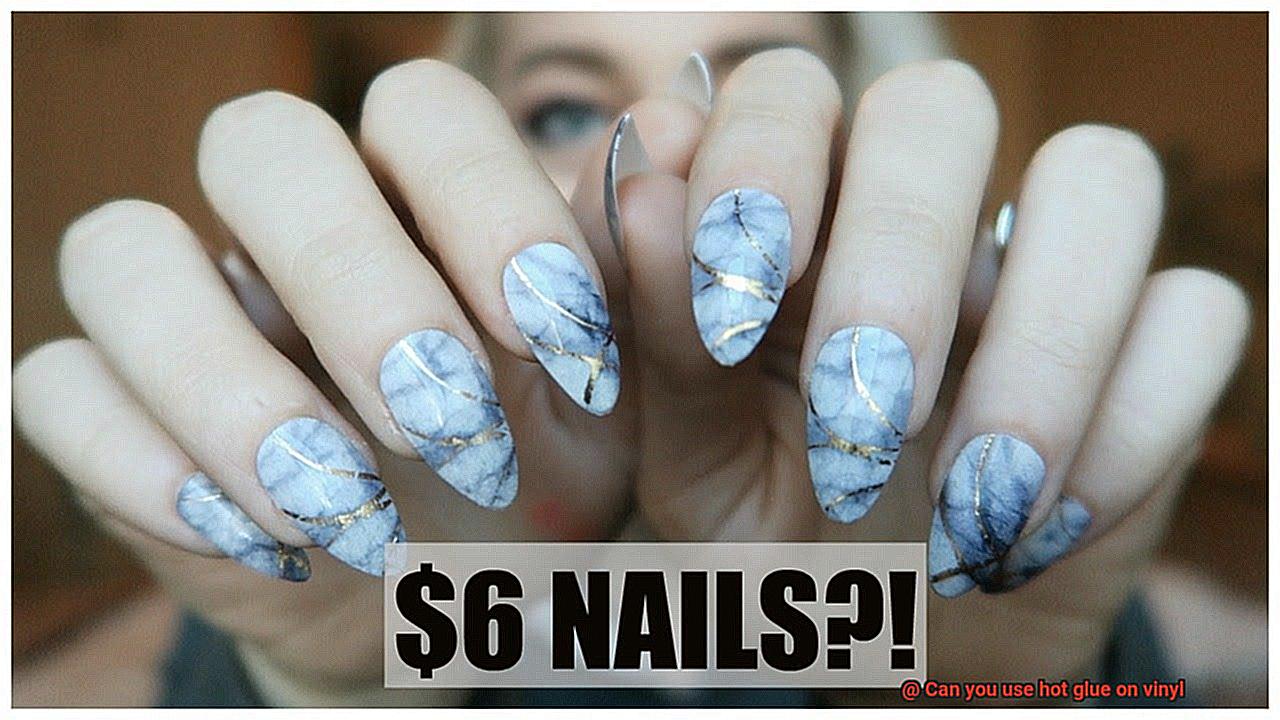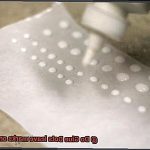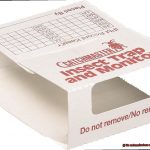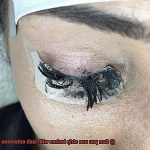Are you itching to unleash your creativity but unsure if hot glue is up to the task? Well, fret no more because we’ve got you covered.
Get ready to dive headfirst into the captivating world of hot glue and its compatibility with vinyl. We’ll answer the burning question: can these two materials coexist in perfect crafting harmony or will they clash like oil and water?
So, grab your trusty glue gun and prepare to embark on a thrilling journey through endless possibilities.
What is Hot Glue?
Contents
Hot glue is a remarkable adhesive that has become a staple in the world of crafting and do-it-yourself (DIY) projects. From bonding materials together to creating intricate designs, hot glue offers endless possibilities. In this article, we will delve into the concept of hot glue, explore its composition, and provide valuable insights on using it effectively in various applications.
What is Hot Glue?
Hot glue, also known as hot melt adhesive, is a thermoplastic adhesive that combines polymers, resins, and additives. It undergoes a transformation when subjected to high temperatures, melting into a viscous liquid that can be effortlessly applied to surfaces. As it cools down and solidifies, hot glue forms a robust bond between materials.
Composition:
At the core of hot glue lies a thermoplastic polymer, such as ethylene-vinyl acetate (EVA) or polyamide. These polymers possess low melting points, enabling them to melt rapidly under heat. Resins and additives are integrated into the mixture to enhance the adhesive properties of the glue. Flexibility, strength, and adhesion to diverse materials are improved through these additions.
Using Hot Glue Effectively:
When employing hot glue in your projects, it is crucial to consider its compatibility with different surfaces. In particular, working with hot glue on vinyl surfaces demands special attention. Vinyl is a synthetic material that exhibits variations in composition and texture, necessitating careful selection of the appropriate type of hot glue.
Key Considerations:
- Specialized adhesives: Opt for specialized vinyl adhesives or high-temperature hot glues specifically formulated for vinyl applications. These products are designed to establish strong and durable bonds without causing damage or discoloration.
- Test before application: Always conduct a small, inconspicuous test before applying hot glue to the entire vinyl surface. This preliminary step ensures proper adhesion and prevents potential harm to the material.
- Low-temperature hot glue gun: Whenever possible, utilize a low-temperature hot glue gun. These guns operate at lower heat settings, reducing the risk of damaging the vinyl.
- Apply sparingly: To avoid excessive seepage into the vinyl, which can lead to damage, it is essential to apply hot glue sparingly. Additionally, exercise caution when bonding materials together to avoid exerting excessive pressure.
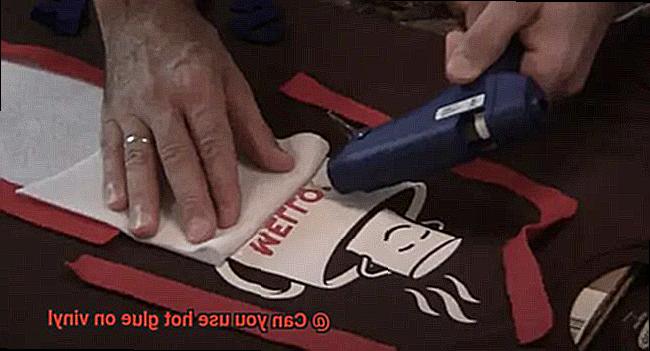
Alternatives to Hot Glue:
In instances where hot glue may not be suitable for your vinyl project, alternative adhesive options abound. Fabric glue, vinyl adhesive, or contact cement are specifically formulated for bonding vinyl surfaces and can deliver a robust bond without compromising the integrity of the material.
What is Vinyl?
The answer lies in vinyl, a material that’s quietly making waves in various industries and finding its way into our everyday lives.
So, what exactly is vinyl? It’s not just any ordinary plastic. Vinyl is a superhero material made from polyvinyl chloride (PVC), a synthetic polymer. Its incredible properties set it apart from other plastics, making it a versatile and indispensable material.
Let’s start with vinyl records. These iconic symbols of music culture have been around for decades. Vinyl’s durability and flexibility make it the perfect medium for audio recordings. Unlike earlier formats like shellac or wax cylinders, vinyl records can deliver better sound quality and longer playing times. The crackling sound as the needle glides across the grooves adds to the magic of vinyl.
But vinyl isn’t limited to music lovers; it’s also found under our feet as flooring. Vinyl flooring has become a popular choice due to its affordability, durability, and easy maintenance. It can mimic the look of wood or stone, adding a touch of elegance to any space. Its resistance to wear and tear makes it perfect for high-traffic areas.
Vinyl is not only used in records and floors; it’s also taking over the construction industry. From window frames to siding, gutters to roofing materials, vinyl is everywhere. Why? It can withstand harsh weather conditions like extreme temperatures and moisture, acting as a shield protecting our homes from Mother Nature’s wrath.
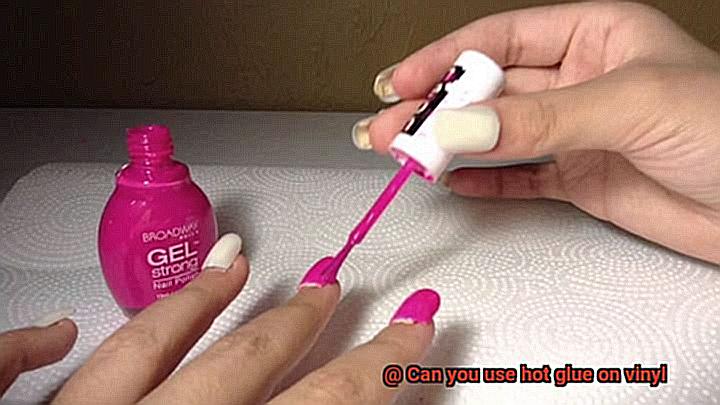
But wait, there’s more. Vinyl has become the darling of crafting enthusiasts too. With vinyl sheets in different colors and finishes, you can let your imagination run wild. Create personalized decals, stickers, or even custom apparel – the possibilities are endless with vinyl.
Can You Use Hot Glue on Vinyl?

Can this dynamic duo create magical results or turn into a crafting nightmare? Let’s delve into the pros and cons of using hot glue on vinyl and discover the best practices for success in your projects.
Pros of Using Hot Glue on Vinyl:
- Quick and Easy: Hot glue dries rapidly, letting you complete projects efficiently.
- Strong Bond: When applied correctly, hot glue can create a sturdy bond between vinyl surfaces.
- Versatility: From repairs to embellishments and joining pieces together, hot glue can handle a wide range of vinyl applications.
Cons of Using Hot Glue on Vinyl:
- Potential for Damage: High temperatures from the hot glue gun can melt or damage certain types of vinyl if not used with caution.
- Surface Texture Challenges: Smooth vinyl surfaces may lack enough texture for the hot glue to adhere properly, resulting in weak bonds.
- Limited Flexibility: Over time, hot glue can become brittle, causing the bond to weaken when exposed to frequent movement or temperature fluctuations.
Best Types of Adhesives for Vinyl:
- Vinyl Adhesives: Specifically designed for bonding vinyl, these adhesives provide flexibility and durability.
- Contact Cement: This adhesive creates a strong bond between vinyl surfaces but requires careful application due to its fast-drying nature.
- Epoxy Resin: Ideal for heavy-duty applications, epoxy resin forms a strong and long-lasting bond on vinyl.
Safety Precautions:
- Low-Temperature Glue Gun: Opt for a low-temperature hot glue gun to minimize the risk of damaging the vinyl.
- Test First: Always test the hot glue on a small, inconspicuous area of the vinyl to ensure compatibility.
- Work Quickly: Hot glue cools and hardens fast, so apply it in small amounts and work efficiently for optimal results.
- Press Firmly: To ensure a strong bond, press the two surfaces together firmly immediately after applying the hot glue.
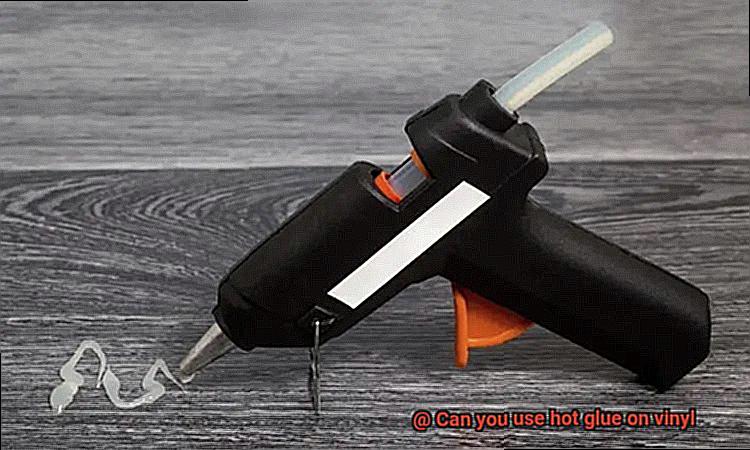
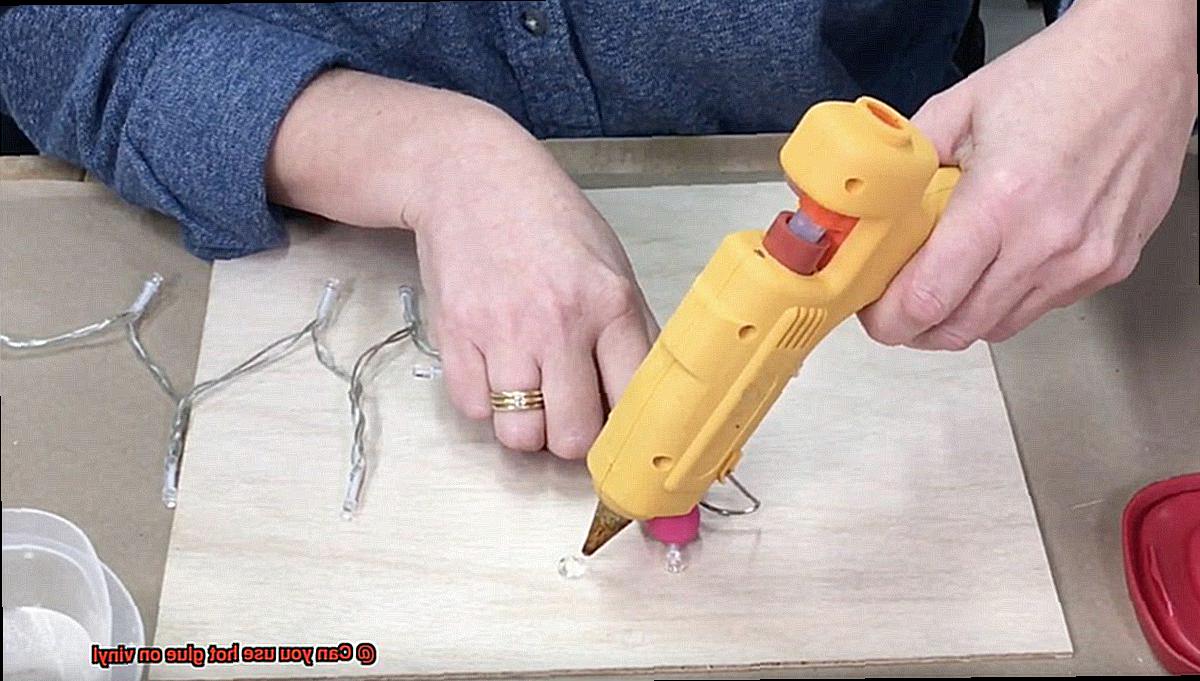
The Impact of Temperature and Humidity:
Temperature and humidity can affect the durability of the bond created by hot glue on vinyl. Extreme temperature variations or high humidity levels may weaken the bond over time. Consider using alternative adhesives with better resistance to these environmental factors for long-lasting results.
Pros of Using Hot Glue on Vinyl
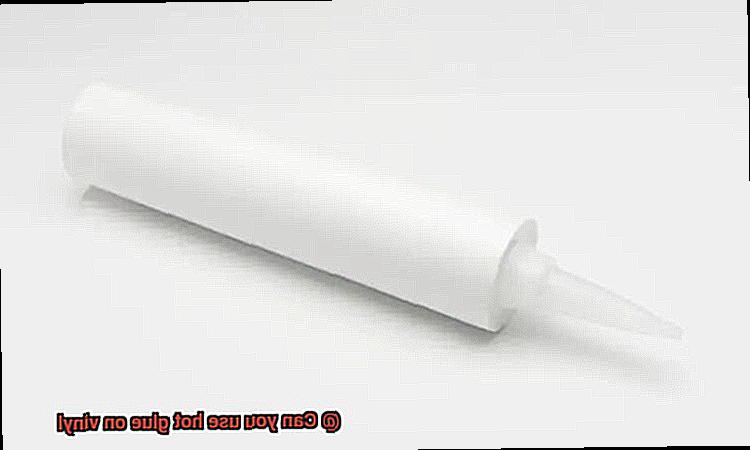
Well, buckle up because we’re about to embark on an exciting journey filled with creativity, innovation, and a whole lot of bonding.
One of the greatest advantages of using hot glue on vinyl is its powerful bonding capabilities. Whether you’re working on upholstery, crafting, or even automotive projects, hot glue can create a secure and durable bond that will stand the test of time. No more worrying about your masterpiece falling apart.
But wait, there’s more. Hot glue is also known for its lightning-fast drying time. Unlike other adhesives that may require hours or even days to dry, hot glue sets within seconds. This means less waiting around and more time for you to unleash your creative genius.
Flexibility is another key perk of using hot glue on vinyl. Vinyl is a flexible material found in various applications, and hot glue can adapt to its flexibility without compromising its bond strength. So go ahead and stretch, mold, and shape your vinyl creations without fear.
Now let’s talk about convenience. Hot glue is readily available at most craft stores or online, making it easy to get your hands on. And guess what? You don’t need any fancy equipment or extensive preparation. Just grab your trusty hot glue gun and some glue sticks, and you’re good to go.
Oh, and did I mention that hot glue has a low odor? That’s right. Say goodbye to those unpleasant fumes that can sometimes accompany other adhesives. With hot glue, you can work on projects that require close contact with the adhesive without worrying about any unwanted smells.
And here’s a bonus – hot glue is relatively inexpensive compared to other adhesives out there. So if you’re a frequent vinyl crafter or have multiple projects in mind, hot glue won’t break the bank.
But what about achieving a clean and neat application? Well, fear not. The hot glue gun gives you precise control over the amount and location of the adhesive, resulting in a professional-looking finish that will make others wonder if you’re a crafting wizard.
Now let’s talk about temperature resistance. Once dried, most hot glues are heat-resistant, meaning they can withstand high temperatures without melting or losing their bond strength. So if your vinyl project is going to be exposed to heat or fluctuating temperatures, hot glue has got you covered.
And here’s the cherry on top – hot glue is reversible. Made a mistake or need to remove the glue from your vinyl? No problem. Simply apply some heat using a hairdryer or a heat gun, and the hot glue will soften, allowing you to peel it off without damaging the vinyl surface. It’s like magic.
Cons of Using Hot Glue on Vinyl
Crafters and creators, listen up. Today, we’re going to talk about the not-so-glamorous side of using hot glue on vinyl surfaces. While hot glue may seem like a superhero adhesive, it’s essential to be aware of its potential risks and drawbacks when working with vinyl. So, let’s dive into the cons of using hot glue on vinyl and why you should think twice before reaching for that trusty glue gun.
First, let’s talk about the heat. Hot glue can be a real troublemaker when it comes to vinyl surfaces. Vinyl is a plastic material that easily melts or warps when exposed to high temperatures. And guess what? Hot glue guns typically reach temperatures between 380 and 400 degrees Fahrenheit. Applying hot glue directly onto vinyl can lead to serious damage, leaving your once pristine vinyl looking deformed or discolored. Not exactly the outcome we’re going for, right?
But it doesn’t stop there. Hot glue and vinyl don’t always get along. Vinyl is smooth and non-porous, making it difficult for hot glue to penetrate and create a strong bond. Over time, this can result in the glued parts separating or becoming loose, leaving you with a less-than-stellar finished project.
Oh, and let’s not forget about the mess. Hot glue has a knack for leaving behind unsightly marks or residue on vinyl surfaces. As it cools and hardens, it can create annoying bumps or blobs that ruin the clean look of your project. And if you apply too much glue or unevenly, it may even seep out from the edges, creating an absolute disaster.
Flexibility is also a concern when using hot glue on vinyl. Once it dries, hot glue becomes rigid and inflexible. But guess what? Vinyl likes to move and groove. It expands and contracts with temperature changes or movement. When you combine the rigidity of hot glue with the flexibility of vinyl, you’re just begging for stress points, cracks, and breaks in your material.
And let’s not forget about the type of vinyl you’re working with. Thin or delicate vinyl materials, like vinyl fabric or thin sheets, may not be able to handle the heat (literally.) of hot glue. Using hot glue on these types of vinyl can result in tearing or damage that’ll make you want to throw your glue gun out the window.
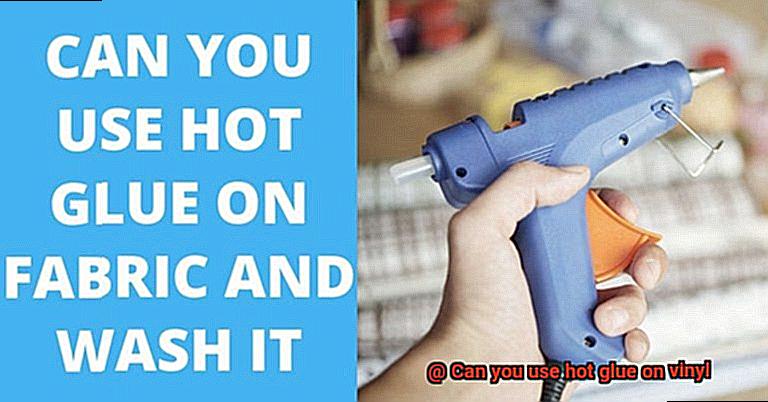
So, before you start gluing vinyl surfaces together with hot glue, consider the potential risks and drawbacks. While hot glue may be handy for some projects, it may not be the best choice for all your vinyl endeavors. It’s always a good idea to explore alternative adhesive options specifically designed for vinyl if you want to ensure a successful and long-lasting bond.
Alternatives to Hot Glue for Bonding Vinyl
I’m here to spill the beans on some fantastic alternatives that will bond vinyl without the mess and damage.
First up, we have vinyl adhesives or cement. These babies are formulated to create a strong and durable bond with vinyl materials. Whether you choose a liquid or gel form, application is a breeze, and you’ll have precise control over where the adhesive goes.
Next on the list is contact adhesive. This stuff is known for its ability to create incredibly strong bonds. Just apply it to both surfaces and press them together. Be sure to choose a formula suitable for vinyl and follow the manufacturer’s instructions carefully.
Looking for something easy-peasy? Double-sided adhesive tapes are your go-to. With a powerful adhesive on both sides, all you need to do is press the surfaces together for a secure bond. Look for tapes specifically designed for bonding vinyl and follow the manufacturer’s recommendations.
If you like a little heat in your projects, heat-activated adhesives can be an excellent option. These adhesives require heat to activate and create a bond. But remember, use the right temperature for your vinyl material to avoid any damage.
In need of a temporary bonding solution? Removable adhesives or adhesive dots are your best friends. They provide a temporary bond that can be easily removed without leaving any residue or damaging your precious vinyl.
When choosing an alternative adhesive for bonding vinyl, consider factors such as the type of vinyl, desired bond strength, and application requirements. Always read and follow the instructions provided by the adhesive manufacturer to achieve the best results.

Tips for Using Hot Glue on Vinyl
Hot glue is a versatile adhesive that can be used for various craft and DIY projects. However, when it comes to using hot glue on vinyl, precautions need to be taken to prevent damage to the material. In this article, we will provide expert tips and precautions for successfully using hot glue on vinyl.
Clean the Surface:
Before applying hot glue to vinyl, it is crucial to clean the surface thoroughly. Any dirt, dust, or oils present on the vinyl can interfere with the adhesive properties of the glue, resulting in a weak bond. To clean the surface, use a mild detergent or rubbing alcohol and a soft cloth. Ensure that the surface is completely dry before proceeding.
Use Low Temperature:
Vinyl has a low melting point, so it is essential to use a low-temperature hot glue gun when working with this material. High temperatures can cause the vinyl to warp or melt, ruining your project. By using a low-temperature gun, you reduce the risk of damaging the vinyl while still achieving a strong bond.
Apply in Small Sections:
To ensure even application and control over the adhesive, it is best to work in small sections when using hot glue on vinyl. Applying too much glue at once can lead to messy and uneven bonding. By working in small sections, you can focus on maintaining an even layer of glue and ensure that it adheres properly.
Maintain Even Pressure:
Applying even pressure while the hot glue sets on the vinyl is crucial for a strong bond. Use clamps or weights to hold the glued parts together until the adhesive cures fully. This will ensure that the adhesive spreads evenly and that there are no gaps or weak spots in the bond. Avoid touching or disturbing the glued area until it cools down and hardens completely.
Removal with Care:
If you need to remove hot glue from vinyl, do so with caution. Apply a low level of heat using a heat gun or hairdryer to soften the glue. Gently peel away the glue using a plastic scraper or your fingertips. Be careful not to apply excessive heat that could damage or distort the vinyl surface.
Conclusion
To conclude, using hot glue on vinyl can yield successful results if approached with care and caution. The rapid drying time, versatility, and strong bonding capabilities of hot glue make it a favored choice among crafters and DIY enthusiasts. However, it is crucial to be mindful of the potential risks and drawbacks before grabbing that trusty glue gun.
One primary concern when working with hot glue on vinyl is the high heat generated by the glue gun, which can lead to damage or even melting of the vinyl surface. To minimize this risk, it is essential to utilize a low-temperature hot glue gun explicitly designed for vinyl applications. Moreover, the smooth texture of vinyl surfaces may pose challenges for adhesion with hot glue due to their lack of roughness.
To ensure a successful bond between hot glue and vinyl, it is advisable to explore specialized adhesives formulated specifically for vinyl applications or consider alternative options such as fabric glue, vinyl adhesive, or contact cement. These alternatives are tailored to bond effectively with vinyl surfaces while preserving their integrity and durability.
When working with hot glue on vinyl, thorough cleaning of the surface beforehand is vital. Applying the adhesive in small sections and maintaining even pressure during bonding will help achieve optimal results. It is also important to exercise caution when removing excess glue using low heat.
In summary, while hot glue can be utilized effectively on vinyl surfaces with proper care and consideration, exploring alternative adhesive options specifically designed for vinyl may be a safer choice in certain situations.

